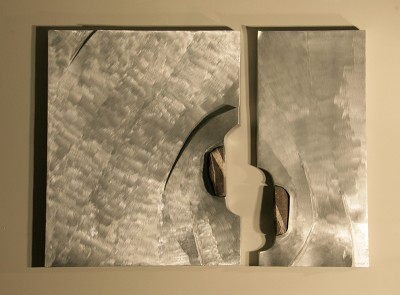Euneclasteia 11
Tetemenon
Like all members of series Rhegmalogia, these pieces address fractures and the forces that create them. Their distinctive characteristic is that they include a stone that has been cut into two or more pieces, which are incorporated into the metalwork out of alignment.
More InformationThe underlying logic and references are multifaceted. There is deliberate ambiguity regarding the narratives: the viewer is thus free to choose or even create a new one. The primary dynamic is slip faulting, where there is lateral displacement from one side to the other. Sometimes it is unclear whether the movements of the metal ʻhost formationʼ has forced the stone apart and is displacing it, or whether the stoneʼs movement is forcing itself through the ʻhostʼ. Observation of nature is like this: cause and effect is often unclear, and decades, even centuries are often required to clarify.
Another dynamic also included regards scientific sampling. The stoneʼs parts may be displaced, the metalworkʼs perimeter is not. Is this because it is a slice through the formation to better investigate it? What about the slice through the metal and the rock? Is it part of the formation being examined, or is it a deliberate cut to examine the inner workings?
The Greek root is temnein, the infinitive form of the word meaning split, cut, hew, sever, and similar concepts. In the form of the title it is perfect past participle neuter: that which has been split.
